Europe Blood Glucose Monitoring Market Size
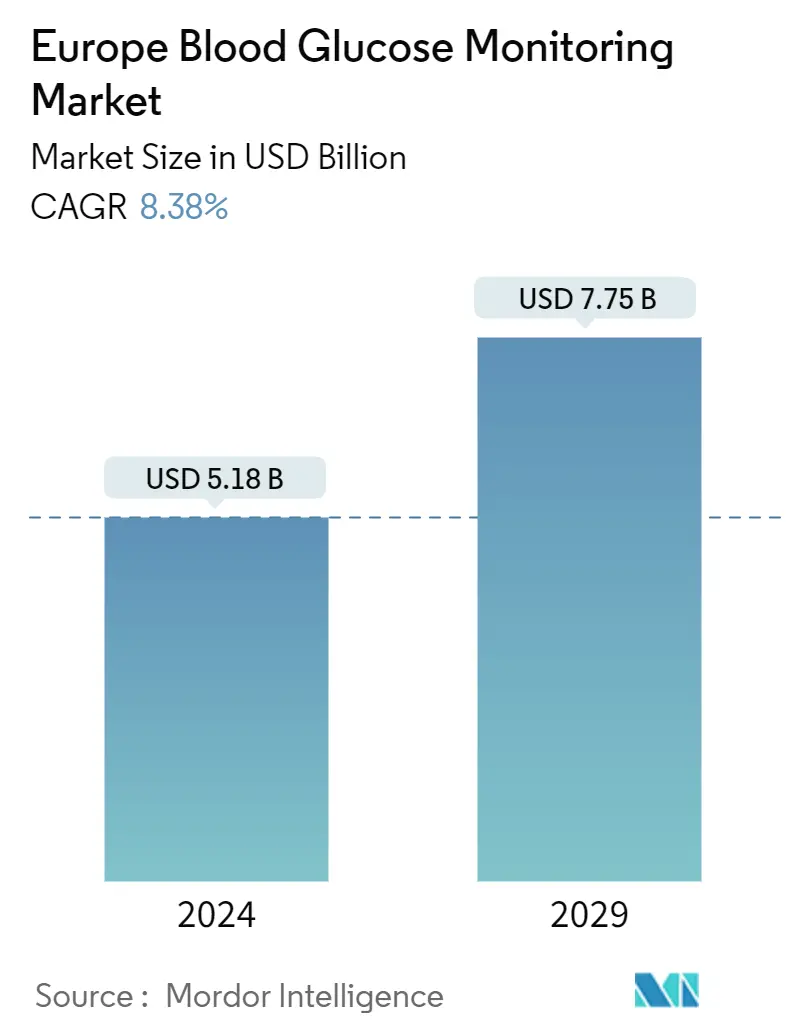
| Study Period | 2019 - 2029 |
| Base Year For Estimation | 2023 |
| Forecast Data Period | 2024 - 2029 |
| Market Size (2024) | USD 5.18 Billion |
| Market Size (2029) | USD 7.75 Billion |
| CAGR (2024 - 2029) | 8.38 % |
Major Players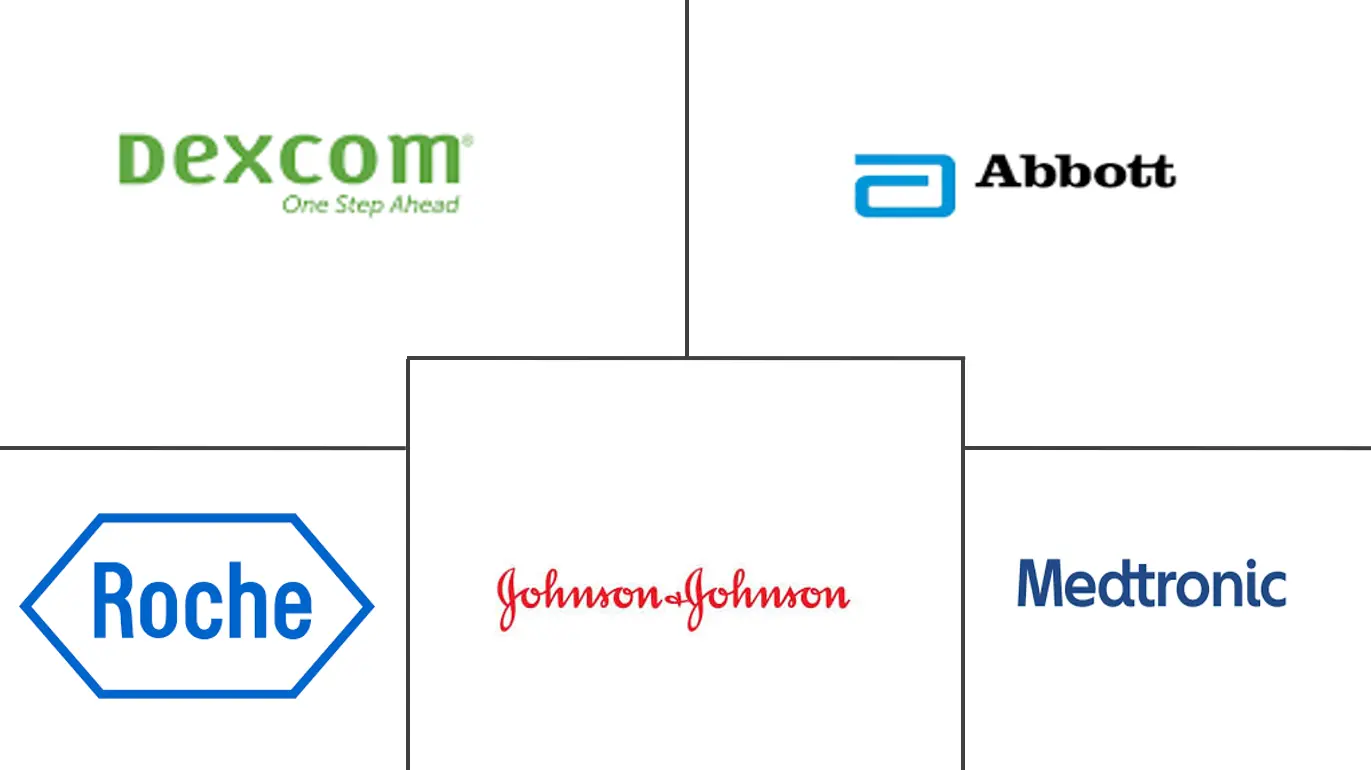
*Disclaimer: Major Players sorted in no particular order |
Need a report that reflects how COVID-19 has impacted this market and its growth?
Europe Blood Glucose Monitoring Market Analysis
The Europe Blood Glucose Monitoring Market size is estimated at USD 5.18 billion in 2024, and is expected to reach USD 7.75 billion by 2029, growing at a CAGR of 8.38% during the forecast period (2024-2029).
The COVID-19 pandemic has substantially impacted the blood glucose monitoring market. Type-1 diabetes patients are impacted more during Covid-19. People with diabetes have a weak immune system, so, with COVID-19, the immune system gets weaker very fast. People with diabetes will have more chances of serious complications than normal people.
According to the diabetes category, the estimated cost per hospital admission during the first wave of COVID-19 in Europe ranged from EUR 25,018 for type 2 diabetes patients in good glycaemic control to EUR 57,244 for type 1 diabetes patients in poor glycaemic control, reflecting a higher risk of intensive care, ventilator support, and a longer hospital stay. The estimated cost for patients without diabetes was EUR 16,993. The expected total direct expenditures for COVID-19 secondary care in Europe were 13.9 billion euros. Diabetes treatment thus accounted for 23.5% of total expenditures.
The European countries are suffering from the burden of high diabetes expenditure. According to the IDF, the overall diabetes expenditure in Europe among the population aged 20-79 years was USD 156 billion, and it is expected to increase to USD 174 billion by 2040. According to other statistics from IDF, every year, 21,600 children are added to the type-1 diabetic population pool. These figures indicate that approximately 9% of the total healthcare expenditure is spent on diabetes in Europe.
With the advancements in technology, blood glucose meters have evolved to include cellular-connected devices. These devices automatically upload self-monitoring blood glucose (SMBG) data to secure cloud-based databases. This allows for improved sharing and monitoring of SMBG data. Real-time monitoring of SMBG data presents opportunities to provide timely support to patients who have abnormal SMBG recordings.
Diabetes remote monitoring programs that utilize these technological advancements can offer additional support to patients with poorly controlled diabetes. This support can significantly improve critical outcomes and enhance market prospects in the future.
For patients relying on insulin pumps or multiple daily injections (MDI) therapy, the CGMs are an effective tool that helps improve glycemic balance without aggregating the danger of severe hypoglycemia.
Therefore, owing to the aforementioned factors, the studied market is anticipated to witness growth over the analysis period.
Europe Blood Glucose Monitoring Market Trends
Continuous Glucose Monitoring Holds Highest Market Share in Europe Blood Glucose Monitoring Market.
CGMs are used to deliver a further descriptive picture of blood glucose patterns and trends than what can be achieved by traditional routine checking of glucose levels at set intervals. The current CGM devices can either retrospectively display the trends in blood glucose levels by downloading the data or give a real-time picture of glucose levels through receiver displays.
Most real-time CGMs can alert patients, parents, or caregivers during actual or pending glycemic visits to facilitate the timely management of blood glucose. This factor, along with the fact that CGM devices are becoming cheaper with the advent of new technologies, like cell phone integration, the CGM market is expected to witness steady growth during the forecast period.
The current CGM devices show a detailed representation of blood glucose patterns and tendencies compared to a routine check of glucose levels at set intervals. These technologies overcome many limitations of self-monitoring blood glucose (SMBG) by fingerprick, allowing it to go beyond HbA1c to check glucose control in diabetes. Furthermore, the current continuous glucose monitoring devices can either retrospectively display the trends in blood glucose levels by downloading the data or give a real-time picture of glucose levels through receiver displays.
The continuous glucose monitoring (CGM) sensors have opened new scenarios to assess, off-line, the effectiveness of individual patient therapeutic plans and stimulated the development of innovative online applications, such as hypo/hyperglycemia alert systems and artificial pancreas closed-loop control algorithms.
In June 2022, Cequr, the leader in wearable diabetes technology, released its newest and most innovative insulin delivery device yet, the Insulin Pen 2.0TM. The pen is small enough to be always worn on the user's body, and it also features a built-in blood glucose meter so that users can track their blood sugar throughout the day.
The rise in national awareness of diabetes is anticipated to drive the adoption of both SMBGs and CGMs on account of the prognostic and diagnostic treatment of diabetes.
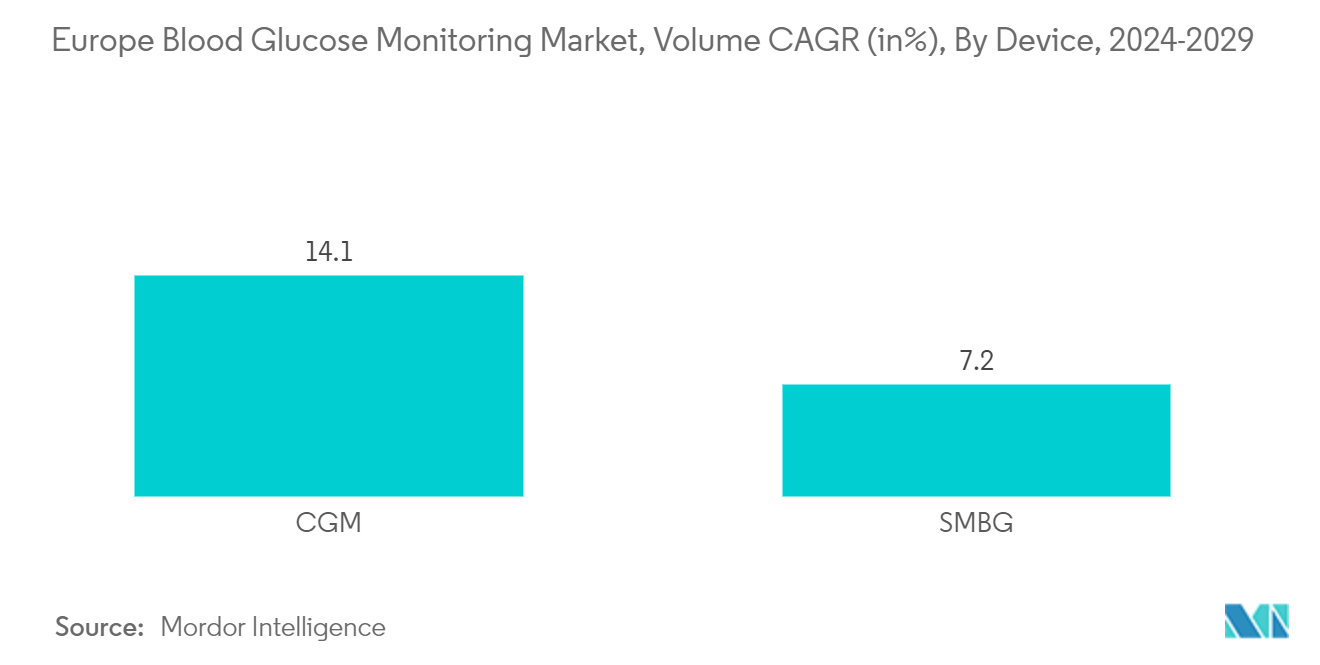
Germany is Expected to Dominate the Europe Blood Glucose Monitoring Market.
In 2022, Germany accounted for 31.87% of the European market. According to the German Diabetes Centre (DDZ), at least 7.2% of the population in Germany currently lives with diabetes which will increase significantly over the next two decades. The prevalence of known type 1 & 2 diabetes in the German adult population is very high, along with many patients not yet diagnosed with the disease. Due to an aging population and unhealthy lifestyle, the prevalence of type 2 diabetes is expected to increase steadily over the next few years.
During COVID-19, the Health Ministry announced that Germany had bought 200,000 doses of experimental antibody cocktails for EUR 400 million to be administered at university hospitals and used only on high-risk diabetic patients at an early stage of the illness. At least 7.2 percent of the population in Germany currently has diabetes, the majority of which is type 2 diabetes, depending on the estimate.
The number of persons with diabetes will climb dramatically in the next two decades. Up to 12 million individuals in Germany could have type 2 diabetes in 20 years, according to researchers from the Robert Koch Institute (RKI) in Berlin and the German Diabetes Center (DDZ) in Düsseldorf. From 2015 to 2040, this would represent an up to 77% increase.
The German Diabetes Society is one of the largest medical-scientific societies in Germany. The organization supports the research and training of medical personnel and develops medical guidelines for the diagnosis of diabetes.
Therefore, owing to the factors above, the growth of the studied market is anticipated in the Europe Region.
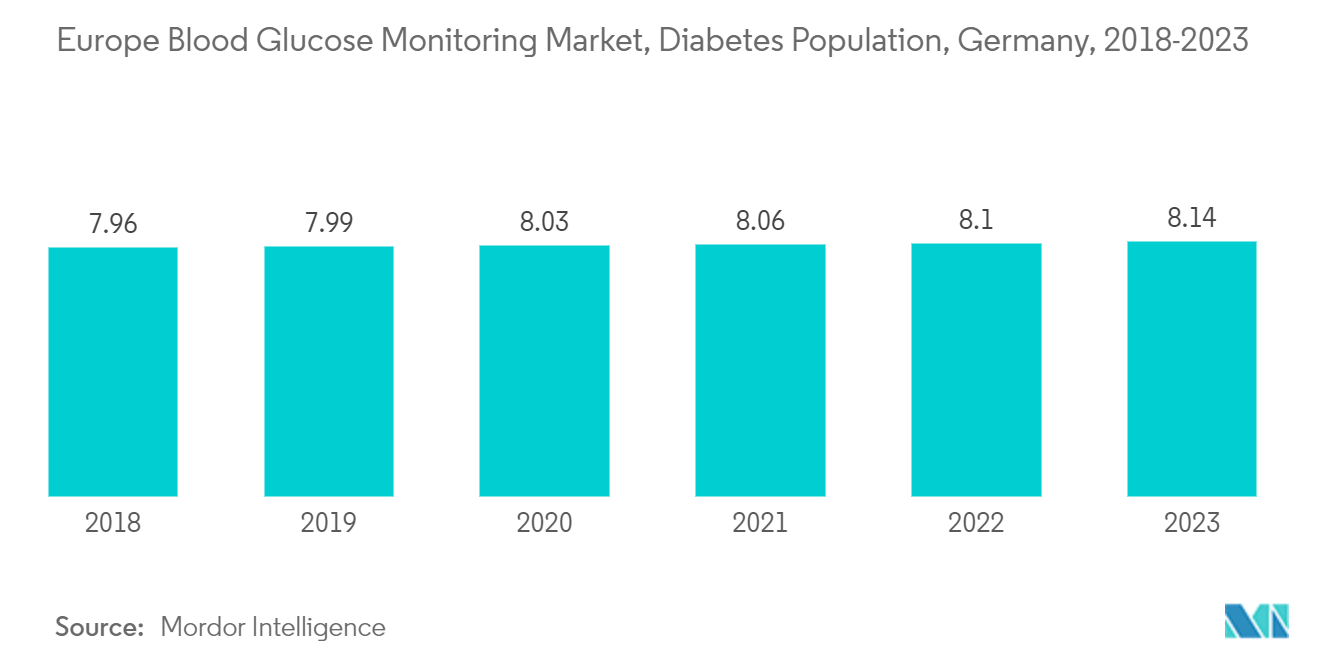
Europe Blood Glucose Monitoring Industry Overview
The blood glucose monitoring market is highly fragmented, with few major manufacturers present in the market. The CGM devices market is dominated by major players like Dexcom, Medtronics, Abbott, and Senseonics. The market for BGM devices comprises more generic players like Roche, LifeScan, Arkray, Ascensia, etc. Technological innovations in the recent past helped companies to strengthen their market presence.
Europe Blood Glucose Monitoring Market Leaders
Dexcom
Abbott
Johnson & Johnson
Medtronic
F. Hoffmann-La Roche AG
*Disclaimer: Major Players sorted in no particular order
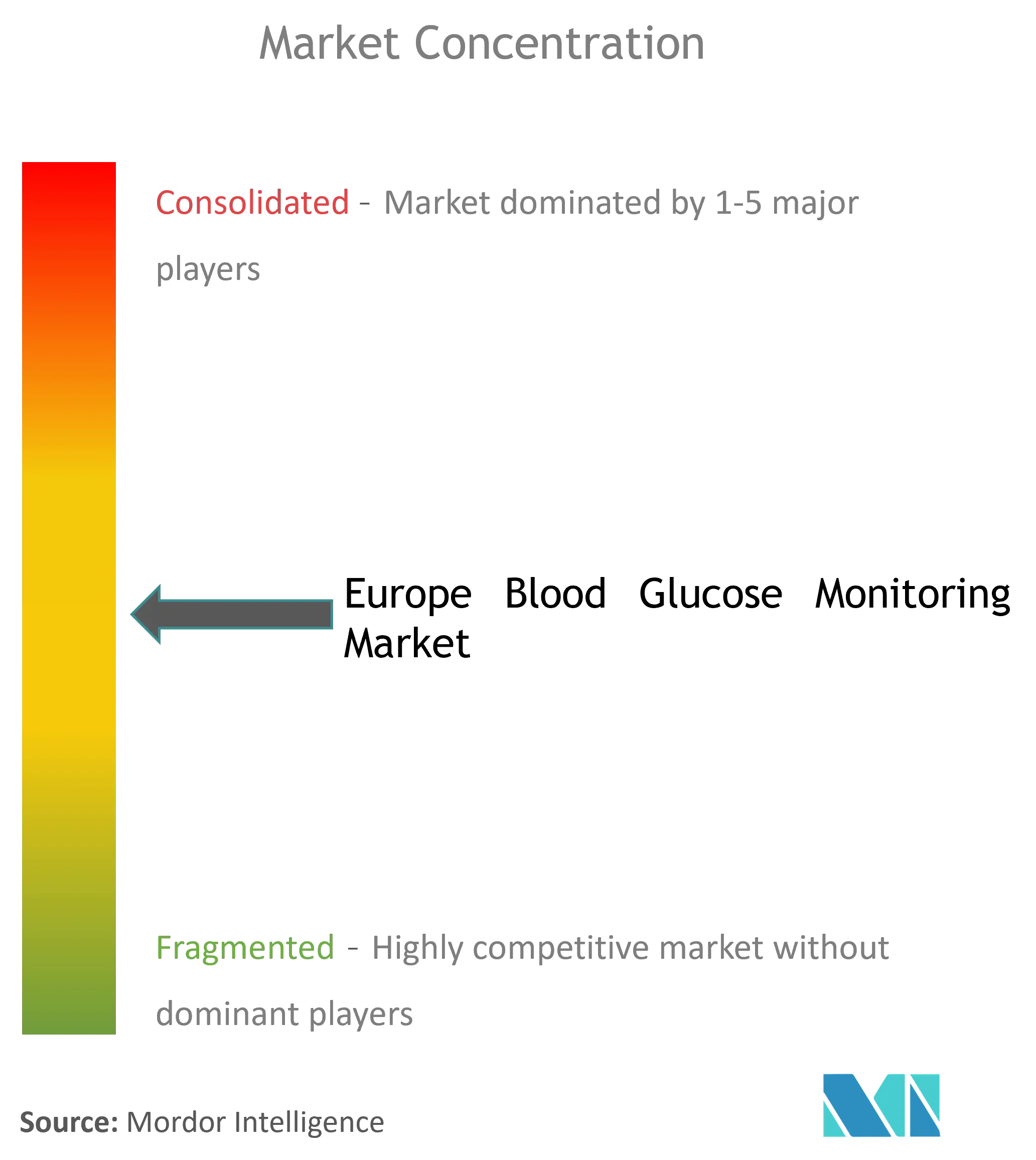
Europe Blood Glucose Monitoring Market News
- October 2023: In Europe, the Simplera, a novel continuous glucose monitor (CGM) developed by Medtronic, received approval. This advanced device, suitable for individuals with diabetes aged 2 years and above, represents a significant improvement over the Guardian 4 sensor. Notably, the Simplera is half the size of its predecessor, disposable, and eliminates the need for fingersticks. Moreover, its streamlined two-step insertion process minimizes the likelihood of errors.
- March 2022: DexCom announced the receipt of a CE Mark for its G7 CGM system in Europe, intended for people who have diabetes and are two years and older, including pregnant women. With this approval, the world's highly popular and best-selling real-time CGM is now more powerful and easier to use with a small, all-in-one wearable and completely redesigned mobile app.
- February 2021: Roche announced the launch of the new Accu-Chek Instant system, a new 'connected' blood glucose monitoring (BGM) system, which supports and enables Roche's approach of integrated Personalised Diabetes Management (iPDM). Accu-Chek Instant features Bluetooth-enabled connectivity to the mySugr app, allowing wireless transfer of blood glucose results to the mySugr app.
Europe Blood Glucose Monitoring Market Report - Table of Contents
1. INTRODUCTION
1.1 Study Assumptions and Market Definition
1.2 Scope of the Study
2. RESEARCH METHODOLOGY
3. EXECUTIVE SUMMARY
4. MARKET DYNAMICS
4.1 Market Overview
4.2 Market Drivers
4.3 Market Restraints
4.4 Porter's Five Forces Analysis
4.4.1 Bargaining Power of Suppliers
4.4.2 Bargaining Power of Consumers
4.4.3 Threat of New Entrants
4.4.4 Threat of Substitute Products and Services
4.4.5 Intensity of Competitive Rivalry
5. MARKET SEGMENTATION
5.1 Self-monitoring Blood Glucose Devices
5.1.1 Glucometer Devices
5.1.2 Test Strips
5.1.3 Lancets
5.2 Continuous Glucose Monitoring
5.2.1 Sensors
5.2.2 Durables
5.3 Geography
5.3.1 France
5.3.2 Germany
5.3.3 Italy
5.3.4 Spain
5.3.5 United Kingdom
5.3.6 Russia
5.3.7 Rest of Europe
6. MARKET INDICATORS
6.1 Type-1 Diabetes population
6.2 Type-2 Diabetes population
7. COMPETITIVE LANDSCAPE
7.1 Company Profiles
7.1.1 Abbott
7.1.2 F. Hoffmann-La Roche AG
7.1.3 Johnson & Johnson
7.1.4 Dexcom
7.1.5 Medtronic
7.1.6 Arkray
7.1.7 Ascensia Diabetes Care
7.1.8 Agamatrix Inc.
7.1.9 Bionime Corporation
7.1.10 Acon
7.1.11 Medisana
7.1.12 Trivida
7.1.13 Rossmax
- *List Not Exhaustive
8. MARKET OPPORTUNITIES AND FUTURE TRENDS
Europe Blood Glucose Monitoring Industry Segmentation
One of the greatest methods to comprehend diabetes and how various meals, drugs, and activities affect diabetes is to test your blood sugar levels. Monitoring blood glucose levels can assist a doctor in creating a management strategy for this illness. Europe's human insulin drugs market is segmented into drugs and geography. The report offers the value (in USD) and volume (in units) for the above segments.
| Self-monitoring Blood Glucose Devices | |
| Glucometer Devices | |
| Test Strips | |
| Lancets |
| Continuous Glucose Monitoring | |
| Sensors | |
| Durables |
| Geography | |
| France | |
| Germany | |
| Italy | |
| Spain | |
| United Kingdom | |
| Russia | |
| Rest of Europe |
Europe Blood Glucose Monitoring Market Research FAQs
How big is the Europe Blood Glucose Monitoring Market?
The Europe Blood Glucose Monitoring Market size is expected to reach USD 5.18 billion in 2024 and grow at a CAGR of 8.38% to reach USD 7.75 billion by 2029.
What is the current Europe Blood Glucose Monitoring Market size?
In 2024, the Europe Blood Glucose Monitoring Market size is expected to reach USD 5.18 billion.
Who are the key players in Europe Blood Glucose Monitoring Market?
Dexcom, Abbott, Johnson & Johnson, Medtronic and F. Hoffmann-La Roche AG are the major companies operating in the Europe Blood Glucose Monitoring Market.
What years does this Europe Blood Glucose Monitoring Market cover, and what was the market size in 2023?
In 2023, the Europe Blood Glucose Monitoring Market size was estimated at USD 4.75 billion. The report covers the Europe Blood Glucose Monitoring Market historical market size for years: 2019, 2020, 2021, 2022 and 2023. The report also forecasts the Europe Blood Glucose Monitoring Market size for years: 2024, 2025, 2026, 2027, 2028 and 2029.
EU Glucometer Industry Report
Statistics for the 2024 EU Glucometer market share, size and revenue growth rate, created by Mordor Intelligence™ Industry Reports. EU Glucometer analysis includes a market forecast outlook to 2029 and historical overview. Get a sample of this industry analysis as a free report PDF download.
